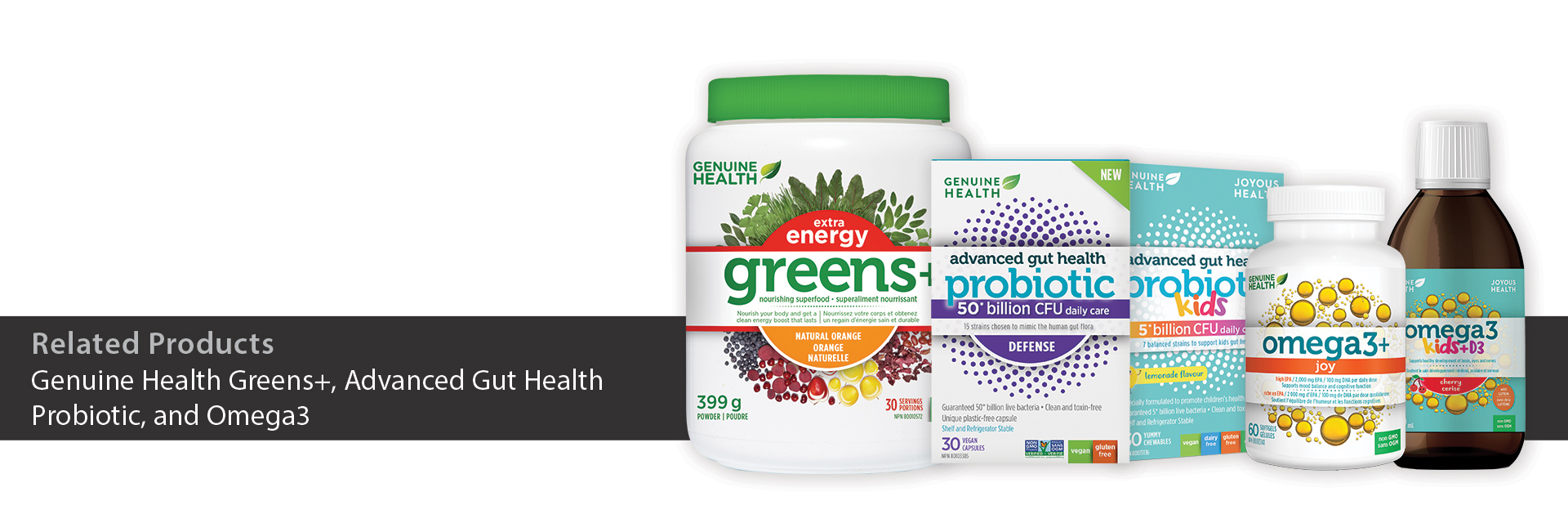

3 Areas of Nutrition You Might Be Missing Out On
You plan meals in order to hit your macronutrients (protein, carbohydrates & fats) each day. Check. You take a multivitamin. Check.
But according to research, you could be missing out on three big areas of nutrition…areas that are important for our physiological functions, like digestion, energy, mood & brain health, healthy aging, prevention of disease and overall resiliency—yet these are unfortunately not easy to get from our diet.
Phytonutrients
Plant foods are awesome, they have so much more to offer than simply micro and macronutrients. They also contain thousands of different bioactive compounds, aka phytonutrients, that provide physiological benefits such as fighting free radicals, reducing inflammation and feeding gut bacteria! But you may be surprised to learn that you’re not getting the phytonutrients you need from food. Here’s why:
- We’re not eating enough plant foods.Based on the 2004 Canadian Community Health Survey, most Canadians had low intake of fruits and vegetables, where all these phytonutrients are found4.
- We’re eating the same fruits and veggies.When we do manage to sneak some fruits and veggies in, it’s often the same few options!
- Plants are less nutritious now than they were before!Over the last 50-100 years in developed countries, the concentration of several nutrients has been on the decline, due to a range of factors including farming practices and soil fertility1.
Diversity is KEY when we talk about phytonutrients—each unique compound has a special set of functions. In order to ensure we’re reaping the benefits of these nutrients, it’s important to ensure we are consuming a wide variety. Colours are often indicative of a certain set of phytonutrients contained within a fruit or vegetable; this is why we like to underline the importance of “eating the rainbow”!
Between work, school, and all our other obligations, it’s harder than ever to take time to ensure that we’re getting all the nutrients we need. greens+ by Genuine Health helps to check all these boxes. Made with 23 colourful and phytonutrient-rich superfoods, greens+ is the only superfood that has been backed by 9 studies and is proven to provide a rich source of antioxidants, balance pH and energize the body.
Probiotics
Your digestive system is directly connected with so many other parts within your body, including your immune system and your cognitive function, which is why it’s so important to take good care of it2! We need probiotics now more than ever; stress, over-sanitization and eating habits are just a few ways your microbial balance can be disrupted. At a glance, the market seems to be overwhelmingly saturated with probiotic-fortified foods and supplements! Here are a few things to keep your eye out for when looking at probiotics and probiotic foods:
- Are the probiotics standardized? Often times probiotic-containing foods like yogurt don’t standardize the probiotic content – the CFUs (colony forming units) and strains of bacteria that are used!
- Are you getting a therapeutic dose?When defining the word “probiotic,” the official definition according to the International Scientific Association for Probiotics and Prebiotics calls out that the quantity of bacteria is important and is required to have a therapeutic benefit5.
- Do probiotics arrive alive in your gut? You want to find a probiotic that will ensure targeted delivery to your intestines, where the majority of your bacteria live.
Keeping your eye out for a few key features, such as delayed-release capsules, packaging that minimizes oxygen and moisture exposure and formulations with multiple strains like those found in the advanced gut health probiotic line by Genuine Health, will give you a therapeutic dose of beneficial probiotics that your gut (and body) needs to thrive.
Omegas
When we think of omega-3s, we think of fish oil. The use of omegas in a supplemental form is not a new concept, and for good reason! Omega-3s are an important category of fatty acids and are considered an essential nutrient. This means that we cannot create them within our bodies, and we have to get them from our diets!
Restoring the balance by supplementing with omega-3s is good for our health! Omega-3s have been linked to improvements in cardiovascular disease markers like thrombosis, blood pressure and heart rate, blood lipid levels and vascular function. Omega-3s can also help to support healthy cognitive function, mood and mental outlook, support a healthy brain, and even a healthy gut microbiome by strengthening the gut lining and boosting diversity of bacterial populations.
- Our modern diets set us up for inflammation!There’s evidence to suggest that human beings evolved eating omega-6 and -3 fatty acids in a ratio of around 1:1. This would have been achieved by eating whole foods in their natural state –fish, grass fed meat, certain vegetables, and nuts and seeds. But our modern diets supply us with more omega-6 than we need – and the typical Western diet now provides us with an omega-6 to -3 ratio of around 16:1 which is linked to inflammation!
- Purity can be a concern.It’s not recent news that fish have a bad rap for contamination. At the same time, it’s recommended that for the general population, we should be consuming about 150g of fish per week to ensure we’re getting enough omegas3. There’s a lot of good resources out there to help navigate the waters (pun intended!), and supplementing is also a great option3!
- The ratio of fatty acids can support different health goals.EPA and DHA are well-known for their physiological benefits, ranging from anti-inflammatory actions to cardiovascular health to the all-important gut health—different ratios of EPA & DHA can be used to help achieve different health goals6!
It’s interesting to learn that overall, in North America, we’re doing a fair job at consuming the recommended dose of fish oils, but not adequate amounts of EPA and DHA7! Supplementing with omega 3s with high EPA and DHA content is an easy and effective way to supply these missing nutrients in a way that is sure to be safe and clean. The omega3 line by Genuine Health has an omega-3 supplement for every need, made from wild and sustainably caught fish, purified and checked by a 200+ step process, with high EPA and DHA formulas to address your goals.
So, what does this mean for us? We need nutrients now more than ever before! Although we can’t get everything that we need from our food sources, it is comforting to know that we can lean on supplementation for that extra support.
References:
1. Davis, D. R. (2009). Declining Fruit and Vegetable Nutrient Composition: What Is the Evidence? J Am Soc Hortic Sci, 44(1), 15-19. 21273/HORTSCI.44.1.15
2. Durack, J. and Lynch, S. V. (2019). The gut microbiome: Relationship with disease and opportunities for therapy. J Exp Med, 216(1), 20-40. 1084/jem.20180448
3. Health Canada. (2019). Consumption Advice: Making Informed Choices about Fish. Minister of Health Canada
4. Health Canada. (2016). Evidence Review for dietary Guidance: Summary of Results and Implications for Canada’s Food Guide. Minister of Health Canada.
5. Hill, C. et al. (2014). Expert consensus document. The International Scientific Association for Probiotics and Prebiotics consensus statement on the scope and appropriate use of the term probiotic. Nat Rev Gastroenterol Hepatol, 11(8), 506-514. 1038/nrgastro.2014.66
6. Russel, F. D. & Burgin-Maunder, C. S. (2012). Distinguishing Health Benefits of Eicosapentaenoic and Docosahexaenoic Acids. Mar Drugs, 10(11), 2535-2559. 3390/md10112535
7. Sheppard, K. W., & Cheatham, C. L. (2018). Omega-6/omega-3 fatty acid intake of children and older adults in the U.S.: dietary intake in comparison to current dietary recommendations and the Healthy Eating Index. Lipids Health Dis, 17(1). 1186/s12944-018-0693-9
8. Welch, A. et al. (2010). Dietary intake and status of n–3 polyunsaturated fatty acids in a population of fish-eating and non-fish-eating meat-eaters, vegetarians, and vegans and the precursor-product ratio of α-linolenic acid to long-chain n–3 polyunsaturated fatty acids: results from the EPIC-Norfolk cohort. Am J Clin Nutr, 92(5), 1040-1051. 3945/ajcn.2010.29457

